CO2 Emissions Inventory and Its Uncertainty Analysis of China’s Industrial Parks: A Case Study of the Maanshan Economic and Technological Development Area
Abstract
:1. Introduction
2. Materials and Methods
2.1. Case Park
2.2. Accounting Boundary and Scope
2.3. Accounting Methods
2.3.1. Energy Consumption
- Fossil fuel combustion
- Electricity consumption
- Heat consumption
2.3.2. Industrial Process
2.3.3. Waste Disposal
2.4. Uncertainty Analysis
3. Results and Discussion
3.1. Total Emissions and Emissions Intensity
3.2. Industrial Energy Consumption Emissions by Sectors
3.3. CO2 Flow Charts of 2016 and 2021
3.4. Uncertainty Analyses
3.4.1. Uncertainty in Activity Level Data
3.4.2. Uncertainty in Emission Factors
3.4.3. Uncertainty in Other Sources
3.5. Comparison of the Study Results with That of Previous Studies
4. Conclusions and Policy Implication
4.1. Conclusions
4.2. Policy Implication
4.3. Future Works
Author Contributions
Funding
Institutional Review Board Statement
Informed Consent Statement
Data Availability Statement
Acknowledgments
Conflicts of Interest
References
- Data Amd Statistic. Available online: http://www.iea.org/data-and-statistics/data-browser?country=USA&fuel=CO2%20emissions&indicator=TotCO2 (accessed on 15 August 2022).
- Yu, X.; Chen, H.; Wang, B.; Wang, R.; Shan, Y. Driving forces of CO2 emissions and mitigation strategies of China’s National low carbon pilot industrial parks. Appl. Energy 2018, 212, 1553–1562. [Google Scholar] [CrossRef]
- Fan, Y.; Qiao, Q.; Xian, C.; Xiao, Y.; Fang, L. A modified ecological footprint method to evaluate environmental impacts of industrial parks. Resour. Conserv. Recycl. 2017, 125, 293–299. [Google Scholar] [CrossRef]
- Catalogue of Audit and Announcement of China’s Development Zones (2018 Edition). Available online: http://www.gov.cn/zhengce/zhengceku/2018-12/31/5434045/files/6eea5e4b78a645c1a27c231b152792ef.pdf (accessed on 5 August 2022).
- Main Economic Indicators of National Economic and Technological Development Zones in 2021. Available online: http://wzs.mofcom.gov.cn/article/ezone/tjsj/nd/202205/20220503313451.shtml (accessed on 5 August 2022).
- Guo, Y.; Lv, Y.; Yan, K.; Tian, J.; Chen, L. Low-Carbon Development Pathways of Industrial Parks in China. Chin. J. Environ. Manag. 2021, 13, 49–58. [Google Scholar] [CrossRef]
- Yan, K.; Lv, Y.; Guo, Y.; Tian, J.; Chen, L. Review on Greenhouse Gas Accounting Methods on China’s Industrial Parks. Chin. J. Environ. Manag. 2021, 13, 13–23. [Google Scholar] [CrossRef]
- Block, C.; Van Praet, B.; Windels, T.; Vermeulen, I.; Dangreau, G.; Overmeire, A.; D’Hooge, E.; Maes, T.; Van Eetvelde, G.; Vandecasteele, C. Toward a Carbon Dioxide Neutral Industrial Park. J. Ind. Ecol. 2011, 15, 584–596. [Google Scholar] [CrossRef]
- 2006 IPCC Guidelines for National Greenhouse Gas Inventories. Available online: https://www.ipcc-nggip.iges.or.jp/public/2006gl/index.html (accessed on 11 August 2022).
- 2019 Refinement to the 2006 IPCC Guidelines for National Greenhouse Gas Inventories. Available online: https://www.ipcc-nggip.iges.or.jp/public/2019rf/index.html (accessed on 6 August 2022).
- Minzhe, D.; Rongkang, F.; Zhongfei, C. Blue sky defense in low-carbon pilot cities: A spatial spillover perspective of carbon emission efficiency. Sci. Total Environ. 2022, 846, 157509. [Google Scholar] [CrossRef]
- Hu, Y.; Chi, Y.; Zhou, W.; Wang, Z.; Yuan, Y.; Li, R. Research on Energy Structure Optimization and Carbon Emission Reduction Path in Beijing under the Dual Carbon Target. Energies 2022, 15, 5954. [Google Scholar] [CrossRef]
- Yang, Z.; Sun, H.; Yuan, W.; Xia, X. The Spatial Pattern of the Prefecture-Level Carbon Emissions and Its Spatial Mismatch in China with the Level of Economic Development. Sustainability 2022, 14, 10209. [Google Scholar] [CrossRef]
- Liu, K.; Ni, Z.; Ren, M.; Zhang, X. Spatial Differences and Influential Factors of Urban Carbon Emissions in China under the Target of Carbon Neutrality. Int. J. Environ. Res. Public Health 2022, 19, 6427. [Google Scholar] [CrossRef]
- Wang, H.; Zhang, Z. Forecasting CO2 Emissions Using A Novel Grey Bernoulli Model: A Case of Shaanxi Province in China. Int. J. Environ. Res. Public Health 2022, 19, 4953. [Google Scholar] [CrossRef]
- Wang, W.; Chen, H.; Wang, L.; Li, X.; Mao, D.; Wang, S. Exploration of Spatio-Temporal Characteristics of Carbon Emissions from Energy Consumption and Their Driving Factors: A Case Analysis of the Yangtze River Delta, China. Int. J. Environ. Res. Public Health 2022, 19, 9483. [Google Scholar] [CrossRef]
- Zheng, S.; Huang, Y.; Sun, Y. Effects of Urban Form on Carbon Emissions in China: Implications for Low-Carbon Urban Planning. Land 2022, 11, 1343. [Google Scholar] [CrossRef]
- The Greenhouse Gas Protocol: A Corporate Accounting and Reporting Standard. Available online: https://ghgprotocol.org/sites/default/files/standards/ghg-protocol-revised.pdf (accessed on 16 August 2022).
- Tengfei, H.; Ruijiao, C.; Nini, X.; Xuan, H.; Weiguang, C.; Bingsheng, L. Spatial correlation network structure of China’s building carbon emissions and its driving factors: A social network analysis method. J. Environ. Manag. 2022, 320, 115808. [Google Scholar] [CrossRef]
- Duan, H.; Dong, X.; Xie, P.; Chen, S.; Qin, B.; Dong, Z.; Yang, W. Peaking Industrial CO2 Emission in a Typical Heavy Industrial Region: From Multi-Industry and Multi-Energy Type Perspectives. Int. J. Environ. Res. Public Health 2022, 19, 7829. [Google Scholar] [CrossRef] [PubMed]
- Tengfei, H.; Yuling, M.; Linbo, X.; Wei, F.; Weiguang, C. Carbon emissions in China’s urban residential building sector through 2060: A dynamic scenario simulation. Energy 2022, 254, 124395. [Google Scholar] [CrossRef]
- Song, L.; Fei, X.; Chuyu, X.; Jian, Z.; Ao, B.; Yuexi, L.; Jun, Z. A Big Data-Based Commuting Carbon Emissions Accounting Method—A Case of Hangzhou. Land 2022, 11, 900. [Google Scholar] [CrossRef]
- Liu, L.; Zhang, B.; Bi, J.; Wei, Q.; He, P. The greenhouse gas mitigation of industrial parks in China: A case study of Suzhou Industrial Park. Energy Policy 2012, 46, 301–307. [Google Scholar] [CrossRef]
- Wang, H.; Lei, Y.; Wang, H.; Liu, M.; Yang, J.; Bi, J. Carbon reduction potentials of China’s industrial parks: A case study of Suzhou Industry Park. Energy 2013, 55, 668–675. [Google Scholar] [CrossRef]
- Yu, X.; Zheng, H.; Sun, L.; Shan, Y. An emissions accounting framework for industrial parks in China. J. Clean. Prod. 2020, 244, 118712. [Google Scholar] [CrossRef]
- Liu, W.; Tian, J.; Chen, L. Greenhouse gas emissions in China’s eco-industrial parks: A case study of the Beijing Economic Technological Development Area. J. Clean. Prod. 2014, 66, 384–391. [Google Scholar] [CrossRef]
- Chen, B.; He, G.; Qi, J.; Su, M.; Zhou, S.; Jiang, M. Greenhouse gas inventory of a typical high-end industrial park in China. Sci. World J. 2013, 2013, 717054. [Google Scholar] [CrossRef] [PubMed]
- Guo, Y.; Tian, J.; Zang, N.; Gao, Y.; Chen, L. The Role of Industrial Parks in Mitigating Greenhouse Gas Emissions from China. Environ. Sci. Technol. 2018, 52, 7754–7762. [Google Scholar] [CrossRef] [PubMed]
- Dong, H.; Geng, Y.; Xi, F.; Fujita, T. Carbon footprint evaluation at industrial park level: A hybrid life cycle assessment approach. Energy Policy 2013, 57, 298–307. [Google Scholar] [CrossRef]
- Ban, Y.U.; Jeong, J.H.; Jeong, S.K. Assessing the performance of carbon dioxide emission reduction of commercialized eco-industrial park projects in South Korea. J. Clean. Prod. 2016, 114, 124–131. [Google Scholar] [CrossRef]
- Tuna, G. The Impact of Biomass Energy Consumption on CO2 Emission and Ecological Footprint: The Evidence from BRICS Countries. Int. J. Environ. Res. 2022, 16, 56. [Google Scholar] [CrossRef]
- EMEP/EEA Air Pollutant Emission Inventory Guidebook 2019. Available online: https://efdb.apps.eea.europa.eu/?source=%7B%22query%22%3A%7B%22match_all%22%3A%7B%7D%7D%2C%22display_type%22%3A%22tabular%22%7D (accessed on 15 August 2022).
- Notice of the General Office of the National Development and Reform Commission on the issuance of the First Batch of GHG Emission Accounting Methods and Reporting Guidelines for Enterprises in 10 Industries (for Trial Implementation). Available online: https://www.ndrc.gov.cn/xxgk/zcfb/tz/201311/t20131101_963960.html?code=&state=123 (accessed on 15 August 2022).
- Notice of the General Office of the National Development and Reform Commission on the issuance of the Second Batch of GHG Emission Accounting Methods and Reporting Guidelines for Enterprises in Four Industries (for Trial Implementation). Available online: https://www.ndrc.gov.cn/xxgk/zcfb/tz/201502/t20150209_963759.html?code=&state=123 (accessed on 15 August 2022).
- Notice of the General Office of the National Development and Reform Commission on Printing and Distributing the Third Batch of Greenhouse Gas Accounting Methods and Reporting Guidelines for Enterprises in 10 Industries (for Trial Implementation). Available online: https://www.ndrc.gov.cn/xxgk/zcfb/tz/201511/t20151111_963496.html?code=&state=123 (accessed on 15 August 2022).
- NDRC. Guildelines for Provincial Greenhouse Gas Inventories. Available online: http://www.cbcsd.org.cn/sjk/nengyuan/standard/home/20140113/download/shengjiwenshiqiti.pdf (accessed on 8 September 2022).
- Liu, Y.; Wang, Y.; Li, D. Estimation and uncertainty analysis on carbon dioxide emissions from construction phase of real highway projects in China. J. Clean. Prod. 2017, 144, 337–346. [Google Scholar] [CrossRef]
- Zhang, X.; Liu, K.; Zhang, Z. Life cycle carbon emissions of two residential buildings in China: Comparison and uncertainty analysis of different assessment methods. J. Clean. Prod. 2020, 266, 122037. [Google Scholar] [CrossRef]
- Mo, L.K.; Hyeok, L.M.; Seok, L.J.; Young, L.J. Uncertainty Analysis of Greenhouse Gas (GHG) Emissions Simulated by the Parametric Monte Carlo Simulation and Nonparametric Bootstrap Method. Energies 2020, 13, 4965. [Google Scholar] [CrossRef]
- Liu, Z.; Guan, D.; Wei, W.; Davis, S.J.; Ciais, P.; Bai, J.; Peng, S.; Zhang, Q.; Hubacek, K.; Marland, G.; et al. Reduced carbon emission estimates from fossil fuel combustion and cement production in China. Nature 2015, 524, 335–338. [Google Scholar] [CrossRef]
- Downie, J.; Stubbs, W. Corporate Carbon Strategies and Greenhouse Gas Emission Assessments: The Implications of Scope 3 Emission Factor Selection. Bus. Strategy Environ. 2012, 21, 412–422. [Google Scholar] [CrossRef]
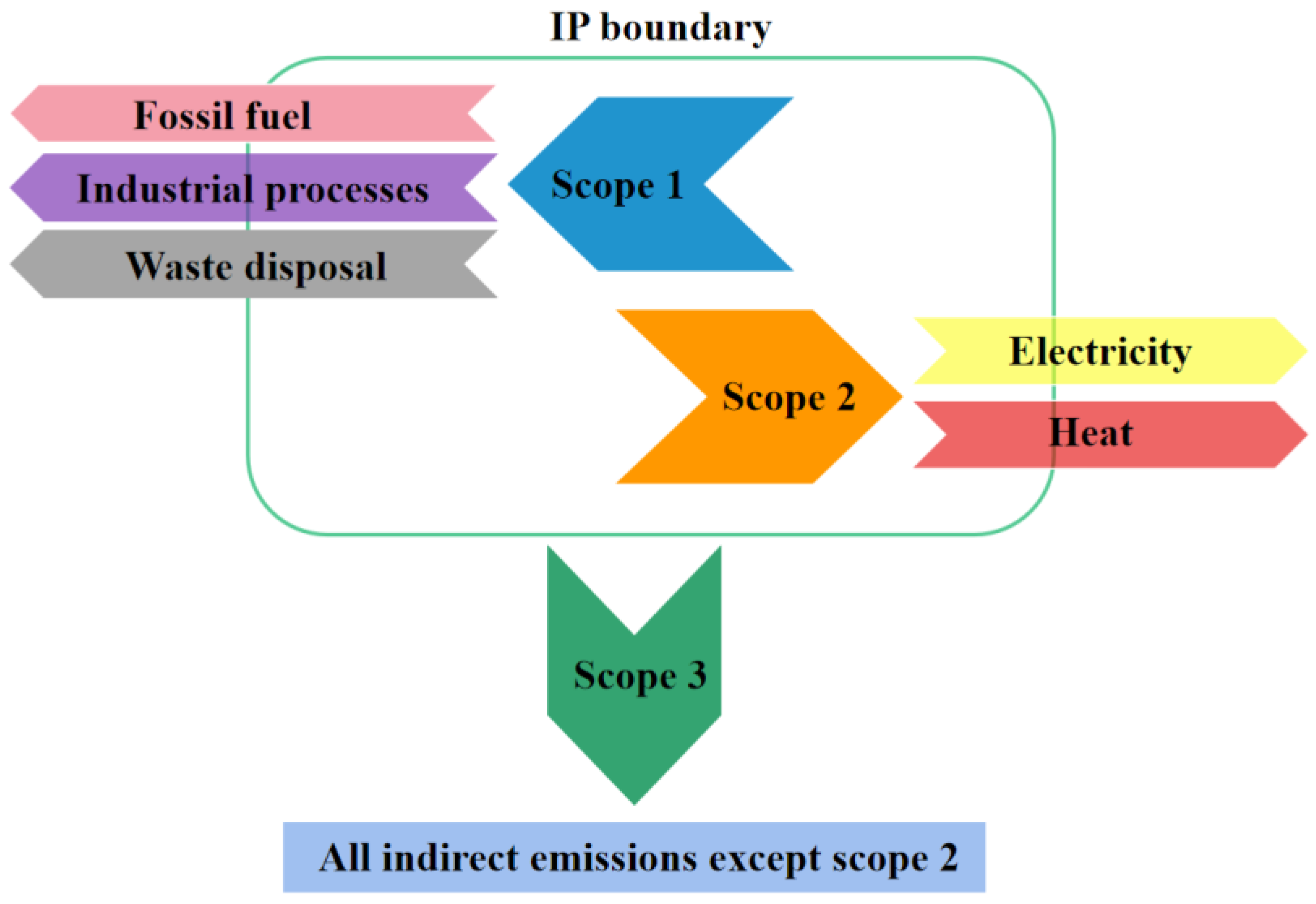

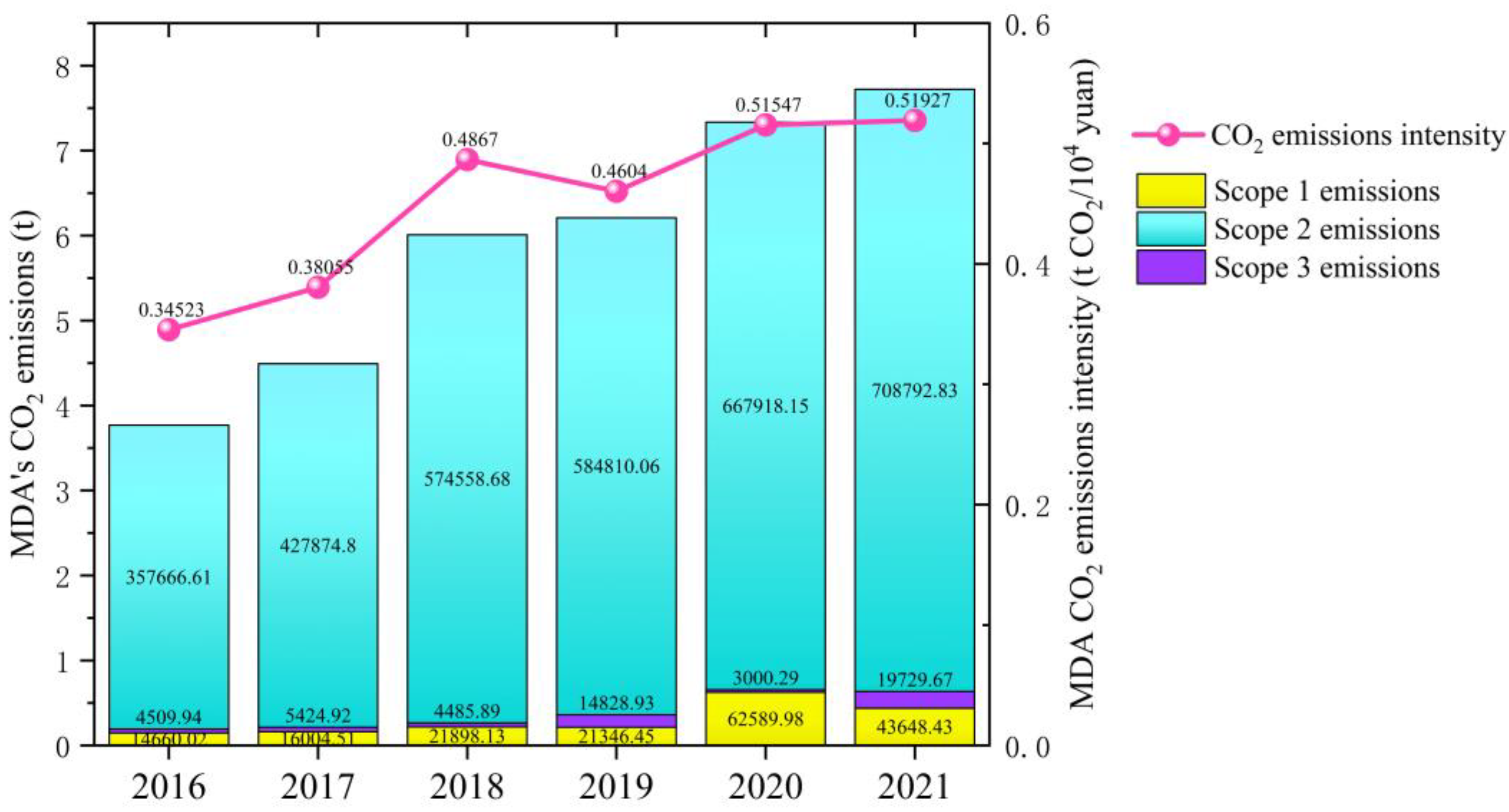
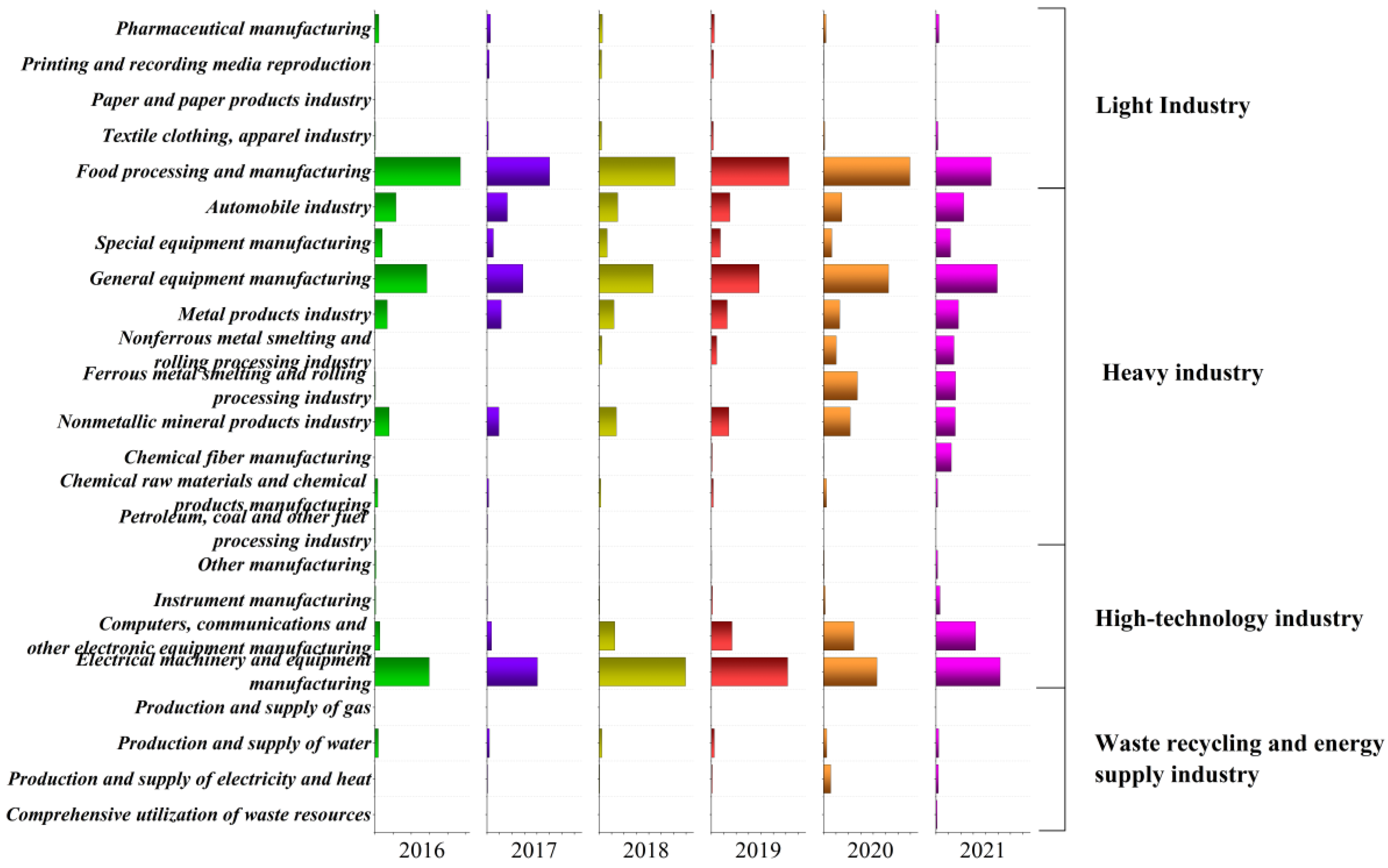
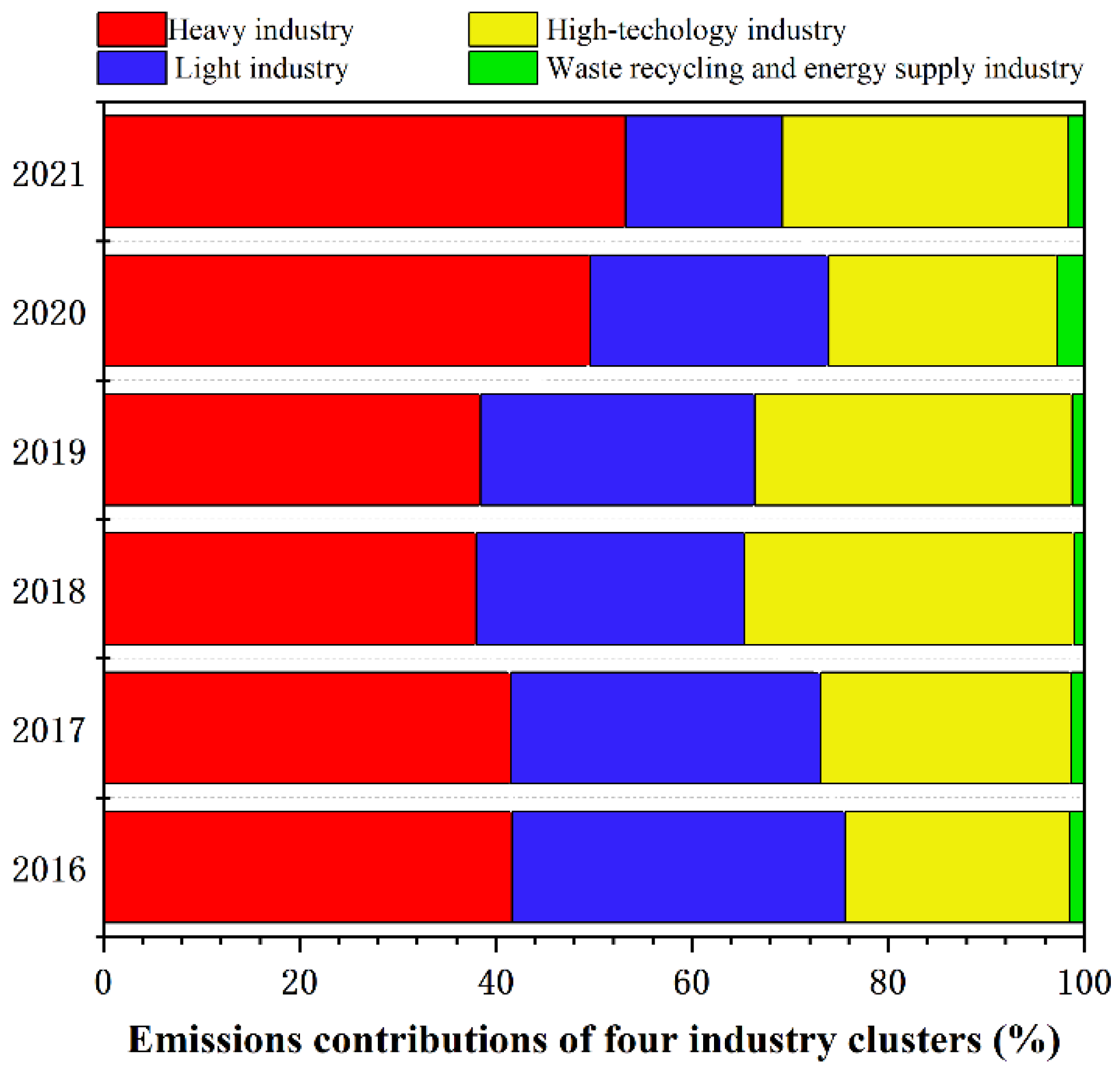
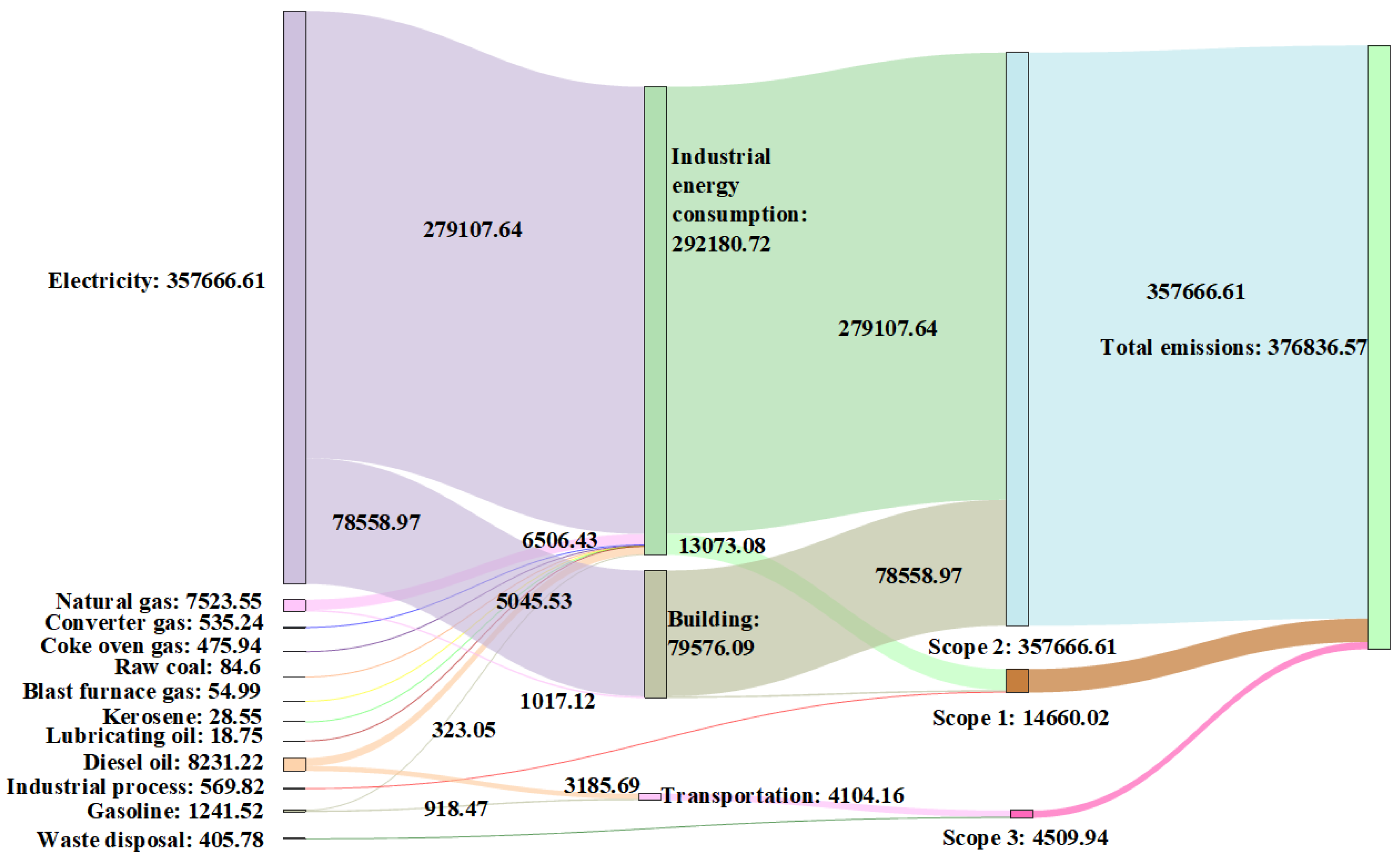
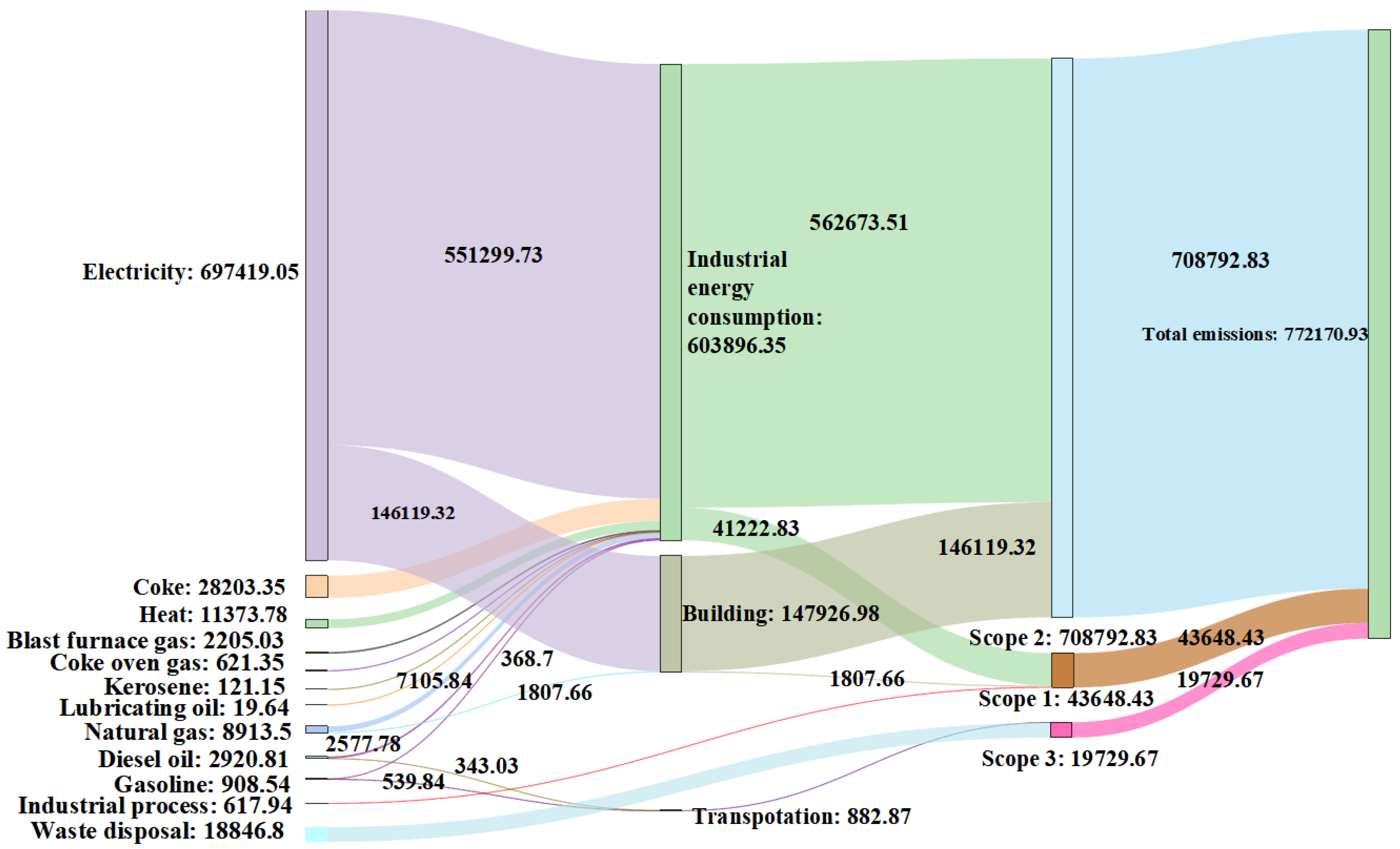
| Parks | Year | GHG Emissions/Mt | Proportion | Reference | ||||
|---|---|---|---|---|---|---|---|---|
| Scope 1 | Scope 2 | Scope 3 | Scope 1 | Scope 2 | Scope 3 | |||
| Suzhou Industrial Park | 2015 | 4.14 | 1.37 | - | 75.11% | 24.89% | - | Yu et al. [25] |
| Nanchang High-tech Industrial Development Zone | 0.16 | 0.90 | - | 15.12% | 84.88% | - | ||
| Laocheng Economic Development Zone | 5.92 | −4.64 | - | 462.34% | −362.34% | - | ||
| Zhengzhou High-tech industrial Development Zone | 0.05 | 0.58 | - | 8.35% | 91.65% | - | ||
| Yongcheng Economic and Technology Development Zone | 2017 | 11.80 | 3.00 | - | 79.73% | 20.27% | - | Zhang et al. [40] |
| 203 National Economic Development Zones | 2015 | 1016 | 71 | 108 | 85.02% | 5.94% | 9.04% | Yan et al. [7] |
| 2016 | 1087 | 8 | 114 | 89.91% | 0.66% | 9.43% | ||
| 2017 | 1194 | −8 | 121 | 91.35% | −0.61% | 9.26% | ||
| Maanshan Economic and Technological Development Area | 2016 | 0.015 | 0.358 | 0.005 | 3.89% | 94.91% | 1.20% | This study |
| 2017 | 0.016 | 0.428 | 0.005 | 3.56% | 95.23% | 1.21% | ||
| 2018 | 0.022 | 0.575 | 0.004 | 3.64% | 95.61% | 0.75% | ||
| 2019 | 0.021 | 0.585 | 0.015 | 3.44% | 94.17% | 2.39% | ||
| 2020 | 0.063 | 0.668 | 0.003 | 8.53% | 91.06% | 0.41% | ||
| 2021 | 0.044 | 0.709 | 0.020 | 5.65% | 91.79% | 2.56% | ||
Publisher’s Note: MDPI stays neutral with regard to jurisdictional claims in published maps and institutional affiliations. |
© 2022 by the authors. Licensee MDPI, Basel, Switzerland. This article is an open access article distributed under the terms and conditions of the Creative Commons Attribution (CC BY) license (https://creativecommons.org/licenses/by/4.0/).
Share and Cite
Zhang, J.; Liu, J.; Dong, L.; Qiao, Q. CO2 Emissions Inventory and Its Uncertainty Analysis of China’s Industrial Parks: A Case Study of the Maanshan Economic and Technological Development Area. Int. J. Environ. Res. Public Health 2022, 19, 11684. https://doi.org/10.3390/ijerph191811684
Zhang J, Liu J, Dong L, Qiao Q. CO2 Emissions Inventory and Its Uncertainty Analysis of China’s Industrial Parks: A Case Study of the Maanshan Economic and Technological Development Area. International Journal of Environmental Research and Public Health. 2022; 19(18):11684. https://doi.org/10.3390/ijerph191811684
Chicago/Turabian StyleZhang, Jian, Jingyang Liu, Li Dong, and Qi Qiao. 2022. "CO2 Emissions Inventory and Its Uncertainty Analysis of China’s Industrial Parks: A Case Study of the Maanshan Economic and Technological Development Area" International Journal of Environmental Research and Public Health 19, no. 18: 11684. https://doi.org/10.3390/ijerph191811684
APA StyleZhang, J., Liu, J., Dong, L., & Qiao, Q. (2022). CO2 Emissions Inventory and Its Uncertainty Analysis of China’s Industrial Parks: A Case Study of the Maanshan Economic and Technological Development Area. International Journal of Environmental Research and Public Health, 19(18), 11684. https://doi.org/10.3390/ijerph191811684






